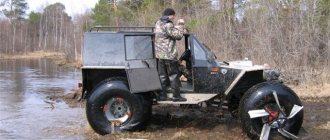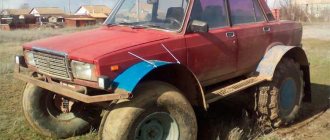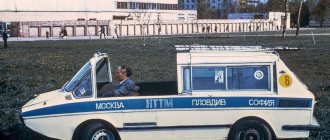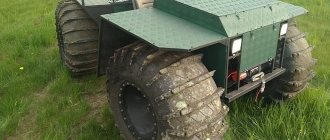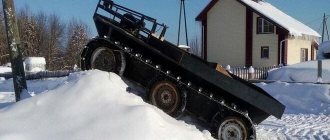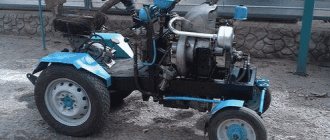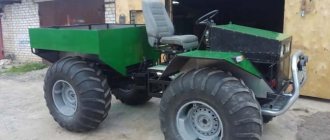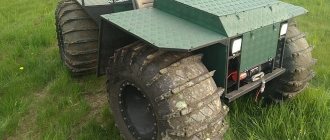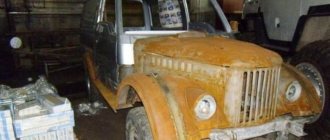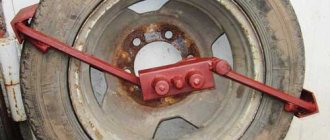A tracked or wheeled all-terrain vehicle from Oka has small dimensions and light weight, which increases maneuverability in forests and wetlands. The production of equipment does not require the use of expensive equipment; parts from production cars are used in the design. It is possible to build a swamp vehicle according to the “karakat” design, which ensures high maneuverability.
Oka base, transmission – Niva
In this “passenger tractor” it is quite difficult to recognize Oka, which the owner managed to install on truly gigantic low-pressure tires on homemade rims, assembled from tubes that had become completely unusable and protected from mechanical damage by a dense fabric layer from a fire hose.
Moreover, the master went even further, providing all-wheel drive in his super SUV, using the transmission from the old Niva for these purposes. It is noteworthy that the entire chassis was also borrowed from the Niva, which makes it possible to overcome almost any off-road terrain.
In addition, a winch was provided on board this hybrid in case of various force majeure. As for the shortcomings, the durability of such tires and chassis does not inspire much confidence, although it is quite possible that these fears are completely unfounded.
Design Features
Making a homemade all-terrain vehicle from Oka is attractive simply because it is more profitable than many officially produced designs. Not only brand new cars, but also cars that have been broken or have been in an accident are suitable as a basis. Many hobbyists create real “universal” all-terrain vehicles that ride on low-pressure tires. Some models are equipped with air cushions.
Tracked vehicles can also be made with your own hands, but this solution is more likely to be suitable for driving on snow, and in the summer months its advantages are, to put it mildly, not obvious.
But everything changes - you just have to go to rough, and especially swampy or heavily humid terrain. There the caterpillars will convincingly demonstrate their superiority. There is no need to buy expensive components. It is worth considering that in wheeled versions all movers are leading. It is useful to use “breaking” frames, which are much more practical than rigid analogues.
Returning to tracked all-terrain vehicles, it should be emphasized that they are especially good for hunters, gamekeepers and fishing enthusiasts . This technique will, of course, be pleasant for connoisseurs of extreme tourism. Most often, the length of the vehicle does not exceed 3 m, because otherwise the cross-country ability is reduced. And there will be more difficulties in manufacturing. In any case, you will have to carry out careful calculations and prepare detailed drawings.
"Lenekhod"
Just by the name of this transport, it becomes clear that its author and designer was a master named Leonid. Indeed, a resident of the city of Nyagan, who built such a miracle of technology, capable of accelerating up to 50 km/h and overcoming any water barriers, bears this very name.
If we talk about the technical characteristics of the snowmobile, then it was built on the body of the same Oka, placed on an all-welded profile frame, receiving a motor from a VAZ-1111 as a power plant.
But for his Lenekhod, Lenya took the steering wheel and all the elements leading to it from an old nine, while he liked the universal base of the Niva as a chassis.
The result is a real hodgepodge of meat, and even on studded SHAIN tires, but the car copes with its duties with a bang, helping the owner transport firewood and other cargo.
Stages of creation
To acquire the design of an SUV, you will need to carry out the following manipulations:
- Finding the basis for the vehicle. Using a motorcycle frame is quite suitable for this. The brand doesn’t matter, it all depends on the financial choice, as well as off-road preferences. This indicator is most developed in IZH motor vehicles.
- Creation of the rear axle and suspension. To do this, you need to use a strut that connects the side members. All this is complemented by a strut and steering bushing, which as a whole form an independent rear suspension. It is recommended to use just such a suspension, because it will provide the product with the necessary maneuverability in difficult places.
- Installation of wheels. In practice, such an all-terrain vehicle based on the Oka is equipped not with the wheels themselves, but with their cameras. They are taken from trucks and attached to the suspension using a hub. Stability is complemented by special tapes that wrap around the wheel. As a rule, cameras from KAMAZ, Ural and cargo trailers are used. This solution increases the reliability of the trip.
- Providing torque and mounting the engine. Such procedures begin to be done after installing the frame and suspension. In addition to the motor, you will also need to install a brake, clutch and exhaust system.
When the entire list of work has been completed, it is necessary to test the device for functionality. If errors are identified, they must be corrected. As practice shows, an illiterately made all-terrain vehicle or swamp vehicle from the Oka can create a danger to others.
Possible nuances
Despite its advantages, this technique has its drawbacks. Frequent troubles are caused by the fragility of low-pressure chambers. Of course, due to the absence of a differential, the vehicle does not require frequent maintenance, but the presence of high pressure in the overall wheels reduces their maneuverability. Also, due to the size of the wheel system, there is a problem with flying dirt, because it is quite difficult to cover them with wings.
Practice shows that pneumatics have poorer maneuverability than the Oka all-terrain vehicle on tracks. The choice of materials used for the design and type of future vehicle directly depends on the purpose of use. More and more people from suburban and rural areas prefer to create such structures, since converting the Oka into an all-terrain vehicle is, first of all, financially beneficial.
A homemade all-terrain vehicle from Oka is profitable and convenient, because the device can be repeatedly modernized and improved. In different weather seasons, its design and characteristics can be changed to adapt them to the weather conditions of the area.
Creating a homemade all-terrain vehicle is a common practice in suburban areas where it is not possible to purchase an expensive car. But it is important to take into account the design features and approach the creation of such a machine with all responsibility. Negligent performance of work can create a risk to the life of the driver and others.
A snow and swamp-going vehicle that can even swim
Even more solid results were achieved by a car mechanic from Rubtsovsk, who used not only the body, but also the Oka engine when creating his unique creation.
To ensure record cross-country ability, allowing the all-terrain vehicle to overcome any off-road conditions, snow drifts and rivers, the designer tried to make this model as light as possible, actually removing rear axles from its design.
In addition, the master made the wheels himself, using the tubes from an old trailer as a basis. In any case, the machine turned out to be quite solid in appearance, having served its owner faithfully for three years in a row.
Moreover, she has attracted the interest of other residents of the Far North, who call the talented master, offering to buy his masterpiece for a considerable sum.
What tools are needed?
To make a homemade all-terrain vehicle based on the Oka car, you will need:
- welding machine;
- equipment for cutting steel profiles;
- drill press or drill;
- set of wrenches;
- tool for cleaning welds;
- hammer;
- Screwdriver Set;
- metal ruler and awl for marking parts.
All-wheel drive Oka
To create this unique all-terrain vehicle, donors such as Oka, which habitually donated its body, UAZ, which donated strong axles to the SUV, and Niva with its durable transfer case, were used.
As for the features of the assembly, among them it is worth highlighting the wheels with tires from KrAZ, spaced from the body, mounted on discs with an offset, springs from the Volga cut into two leaves and its steering, which, although it did not give light turns, but cost zero, in contrast to the previously planned expensive hydraulic booster.
There were also weaknesses, which turned out to be CV joints that quickly fail, as a result of which the owner always has to carry a spare tire with him.
Stages of creation
To acquire the design of an SUV, you will need to carry out the following manipulations:
- Finding the basis for the vehicle. Using a motorcycle frame is quite suitable for this. The brand doesn’t matter, it all depends on the financial choice, as well as off-road preferences. This indicator is most developed in IZH motor vehicles.
- Creation of the rear axle and suspension. To do this, you need to use a strut that connects the side members. All this is complemented by a strut and steering bushing, which as a whole form an independent rear suspension. It is recommended to use just such a suspension, because it will provide the product with the necessary maneuverability in difficult places.
- Installation of wheels. In practice, such an all-terrain vehicle based on the Oka is equipped not with the wheels themselves, but with their cameras. They are taken from trucks and attached to the suspension using a hub. Stability is complemented by special tapes that wrap around the wheel. As a rule, cameras from KAMAZ, Ural and cargo trailers are used. This solution increases the reliability of the trip.
- Providing torque and mounting the engine. Such procedures begin to be done after installing the frame and suspension. In addition to the motor, you will also need to install a brake, clutch and exhaust system.
Snow and swamp-going vehicle on "batteries"
Recently, more and more self-taught craftsmen have been trying to use so-called rubber tires, which more than replace large-radius factory tires that cost a lot of money. As for their processing, this process is not complicated, implying the creation of a new tread on an old tire.
Practice shows that such wheels cope well with off-road conditions, and as an example we can cite the Oka installed on them with a frame and axles from a UAZ, a transfer case from a Niva and an original engine with a gearbox.
Homemade SUVs inspire other car enthusiasts to the most daring feats, especially since their assembly can be limited to old spare parts and cars that have fallen into disrepair. Perhaps that is why every year more and more examples of such works appear on the Internet, which really deserve special attention.
Thoughtful solution
Since in rural areas you often have to navigate difficult terrain, many people want to buy an SUV. Alas, such cars are quite expensive, so you need to know how to make an all-terrain vehicle from the Oka. To create it, they use improvised means, which include spare parts from broken cars and motorcycles.
Among the most popular options for “folk” crafts are “station wagons” based on low-pressure pneumatics or air-cushioned ones. The use of crawler tracks is also common, but they are more suitable for snowy areas.
All-terrain vehicle assembly instructions
To make a wheeled all-terrain vehicle based on the Oka car, you need:
- calculate the chassis structure and prepare detailed drawings;
- assemble a welded frame from a steel profile on a slipway;
- mount suspension elements and rear axle;
- install the steering mechanism on the chassis;
- calculate and install a rocker that allows you to change gears;
- install the power unit;
- carry out final assembly and test the functionality of the structure;
- eliminate detected faults and modify the all-terrain vehicle.
Blueprints
The drawings contain frame dimensions indicating the distances between the installation points of transmission and suspension parts and allow you to calculate the distance between the body and the chassis. The diagrams provide calculation of the amount of steel profile, the strength of the structure is calculated separately. During further test runs, parts may be destroyed, which will have to be reinforced with additional gussets. The reinforcements are made from sheet steel or profiles and then welded to the frame of the all-terrain vehicle.
